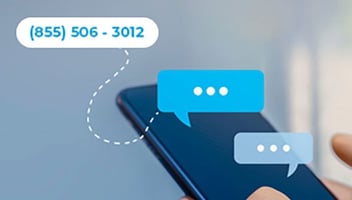Business Communications Today: The Good, the Bad, and the Ugly
Introduction
If there’s one thing pretty much any business or brand owner can agree on, it’s that effectively communicating with customers is super important. Why? Because communication builds and maintains trust between clients and businesses. And when customers trust an organization, they’re more likely to buy from it and remain loyal to it.
There are several different ways companies can reach consumers, including emails, phone calls, direct mail, and in-person interactions. But out of all these, one mode of communication seems to reign supreme: SMS, or text messaging.
Why do people prefer text messages?
Meera surveyed more than 800 American consumers, and a whopping 73.6 percent of respondents revealed they would prefer if banks, insurance agents, telecommunication providers, cable companies — nearly every kind of company they find themselves interacting with — offered to communicate with them via text message.
It’s not hard to understand why they’d answer this way. Though each channel has its pros, some come with a few cons that are truly annoying in this day and age.
Take cold calling (please). While it’s nice to hear a human voice instead of an automated bot on the other end of a call, it is becoming harder and harder to make that connection. Spam filters along with busy consumers would rather not lose a second of their precious time tethered to a conversation, especially when they have no idea who is calling them. Let alone being pitched a service they may not even want or need.
Direct mail and email marketing are getting lost in a sea of emails and are being ignored and lack the ability to create a bond that only a human-to-human conversation can achieve. Simply put, direct mail is too slow and leaves customers’ mailboxes full of junk envelopes, and while email marketing platform was used to be a reliable way for businesses to reach out to their customers, the channel has lost momentum over the years for a few reasons.
THE UGLY
Let’s start with the ugly, modern spam filters have become more advanced and make it hard to trust any message that comes from a sender you don’t know personally, along with many consumers finding much of the content in promotional emails just being plain intrusive.
THE BAD
The Bad, consumers report feeling that most of the emails they receive are a bit too impersonal and formal and just go ignored
THE GOOD
There is an approach that not only helps connect and engage but also the ability to follow up and drive a human-to-human conversation.
Wondering what the solution could be?
SMS!
But not any type of text messaging platform can accomplish this feat. Text messages that are powered by Ai and human-like in nature like Meera.ai have the power to outweigh each of the cons found in other modes of communication.
Here’s why:
Texting is quick. When given the choice between sacrificing a few seconds to read an SMS message or a few minutes to talk to a cold caller on the phone, most people — 48.74 percent of them, to be exact, according to the Meera consumer survey — would choose to give up a few seconds for the text.
Texting is convenient. Some consumers think emails create a false sense of urgency, pressuring them to read the message right away, even if it’s not a good time. And there’s no way of knowing when your phone will ring, so you never know when you’ll be interrupted by a caller. Text messages, however, give the recipient the freedom of reading and respond to the message whenever they please.
Texting is relevant. These days, most people use their mobile phones to text their peers. The preferred means of communication, particularly for Millennials and Gen-Zers, texting should be at the top of the list of any business hoping to appeal to those demographics. No one ever lost adapting their approaches to customer preferences, eh?
How to give the people what they want
So yeah, adapting to audience communication preferences is always a good idea. But, what are the best ways to do so? And really…why bother?
Perhaps the most important reason for brands, businesses. and companies to evolve alongside their customers is to create and maintain a healthy relationship with them. Good consumer-brand relationships are crucial. Why? Because they promote brand loyalty and increase sales.
When customers feel connected to a brand, they feel more comfortable using their services or supporting the brand. Plus, they’re likely to share companies and services they love with their family and friends, creating the opportunity for the brand to reach a wider audience.
So, how do you strengthen the consumer-brand relationship? By giving the people what they want and communicating with them via their preferred channel: text messaging.
Not feeling ready? Start small. Test SMS messaging with a select group of your audience and gauge their response to your efforts. Once you begin seeing positive results, you can use our advanced ai sms marketing platform and start sending texts to the rest of your consumers.
Adapt now–or wish you had
What if you don’t want to evolve?
It may be tempting for a marketer to continue doing things the way they always have, but refusing to evolve and adapt with your audience is risky business!
Poor customer relationships can cause businesses to lose customers, with numbers dropping somewhere between 20 and 80 percent a year. And even if they stick around, customers who don’t feel they have good relationships with a business may forget about it altogether, becoming less likely to reach out the next time they need the goods or services the business provides.
A noneffective communication method will not only cause you to lose current customers but may prevent you from gaining new ones, too. Positive word-of-mouth plays a notable role in any company’s growth. One that’s notorious for poor communication or bad consumer-brand relationships probably won’t get too many recommendations. Customers will be unlikely to speak of the brand’s services, and if they do, there may not be too many positive words spoken.
When is the best time to text customers?
Adding texting functionality to your existing customer relationship management (CRM) or other software can be accomplished in several ways:
1. Utilize a Chrome extension: One option is to integrate a Chrome extension, which acts as a no-code solution for texting directly from your CRM or any web page. With this extension, you can simply click on phone numbers to initiate text messages. It offers a straightforward and flexible approach, and messaging data is stored within your Text Request account unless manually copied into your CRM. For more information, refer to our Text Request Chrome browser extension.
2. Connect a pre-built integration: Many texting services offer pre-built integrations that synchronize contacts and messages between your texting service and CRM. In some cases, these integrations also enable you to send texts directly from your CRM and establish automated messaging workflows. Each integration may have unique features, so explore our selection of pre-built SMS integrations for detailed information.
3. Develop a custom integration: If you have software development resources available, building a custom integration can cater to your specific requirements. This option allows you to tailor the integration to align perfectly with your needs. It is particularly beneficial if you offer software services to businesses and want to introduce new functionality that can be monetized. To explore this option, check out our SMS API documentation and our Partners page.
By considering these three methods—leveraging a Chrome extension, utilizing pre-built integrations, or developing a custom integration—you can seamlessly incorporate texting capabilities into your CRM or other software, enhancing your communication and customer management processes.
When is the best time to text customers?
The best time to text your customers depends on when they are most likely to take action on your message. It's important to consider their availability and receptiveness to ensure the highest level of engagement. For instance, if you operate a boutique, sending promotions about new inventory at 9am on a weekday may not yield the desired results as your customers may not be able to browse or make purchases while they are at work. Similarly, reaching out about a business contract on a Saturday afternoon may not be effective as your contact may not be in a mindset to respond.
Here are some general recommendations for the best times to send text messages based on different industries:
1. Business Services: It is advisable to send texts during standard business hours, from 9am to 5pm on weekdays (Monday to Friday). This ensures that your messages are received when professionals are most likely to be available and focused on work-related matters.
2. Retail: For retail businesses, sending texts in the evenings from 6pm to 8pm and on weekends (from 9am to 8pm) tends to be more effective. This timing allows customers to relax after their workday or on their days off, making them more inclined to engage with your promotions and make purchases.
3. Appointment Scheduling: Early morning through lunchtime on weekdays, specifically from 7am to 2pm, is a suitable time to send texts for scheduling appointments. During this period, individuals are more likely to be organizing their day and making plans.
4. Media & News: When it comes to media and news-related texts, early morning from 7am to 9am and evenings from 6pm to 8pm prove to be the most successful. These time slots coincide with people's routines, as they often catch up on news updates during these hours.
In addition to these industry-specific recommendations, it is crucial to respond promptly to inbound questions and sales inquiries. Regardless of the time received, it's best to respond as soon as possible to maintain customer satisfaction and seize potential business opportunities.
Ultimately, understanding your audience's preferences and behaviors is key to determining the best time to send text messages. Although trial and error can provide valuable insights, paying attention to customer engagement and feedback will help refine your approach and optimize your communication strategies.
So, wondering where and how to start using a more modern approach to communicating.


.png?width=512&height=512&name=guru%20(1).png)

.png?width=199&height=109&name=salesforce-logo1-removebg-preview%20(1).png)


.webp?width=716&height=569&name=banner-img%20(1).webp)



